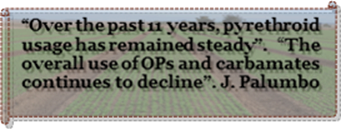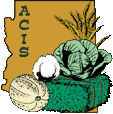
Our annual Lettuce Crop Losses Workshop was recently held in April and the results
of the surveys continue to show consistent trends in insecticide usage on desert
head lettuce. In general, the most commonly used insecticides in fall and spring
lettuce correspond directly to the key pests that typically occur during these growing
periods. By far, the pyrethroids, applied both as foliar sprays and chemigations,
were the most commonly used insecticide class. No surprise there. Over the past
11 years, pyrethroid usage has remained steady. The reason for this is quite clear
to me: pyrethroids are one of the most inexpensive and safe broad spectrum insecticides
still available for use in tank-mixtures for effective control of flea beetles,
crickets, plant bugs and some Lep larvae (looper and earworm). The overall use of
OPs and carbamates continues to decline, but Lannate (methomyl) and acephate are
still relied upon for thrips management. Their usage is being replaced primarily
by several reduced-risk chemistries, of which the spinosyns remain the second most
commonly used class of insecticides. In 2014-2015, nearly 95% of the lettuce acreage
in our area was on average treated with > 2 applications of Radiant or Success.
Their use against both lepidopterous larvae and thrips has remained steady since
they were first registered. Foliar uses of Diamides (Coragen, Voliam Xpress, Vetica,
Belt) were the third most commonly used chemistry in lettuce in 2014-2015. Since
they were first registered in 2008, PCAs have steadily incorporated this new chemical
class into their management programs. The use of Belt increased significantly this
season, whereas soil uses of Coragen continue to decline. Ketoenol usage (Movento)
on fall and spring lettuce increased this season likely due to heavier whitefly
and aphid pressure. Another important class of chemistry used in fall and spring
lettuce is the neonicotinoids driven primarily by soil-applied imidacloprid for
whiteflies and aphids. The usage of imidacloprid on both fall and spring lettuce
has increased markedly since 2009 and is used on almost 90% of the acreage, albeit
at top of the label rates. Foliar neonicotinoid usage also increased last season,
presumably due to heavier whitefly/aphid infestations in 2014-15. Finally, for the
fifth season in a row, PCAs treated a greater percentage of their acreage with selective,
reduced-risk products than with the broadly toxic, older chemistries. To view a
summary of the estimated insecticide usage by chemical class, as well as the 12
most commonly used insecticides on head lettuce this past growing season, go to
Insecticide Usage Summary in Arizona Lettuce 2015.




